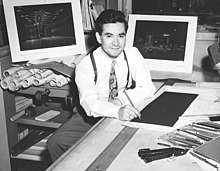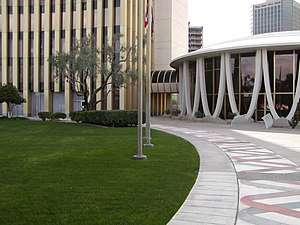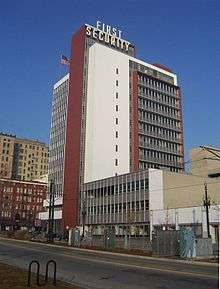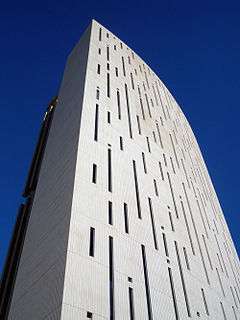Wenceslao Sarmiento
Wenceslao Alfonso Sarmiento (September 28, 1922[1] – 24 November 2013[2]), also known as W.A. Sarmiento is a Peruvian-born American modernist architect.[3]


Sarmiento studied in various locations in South America, for eighteen months in the office of Oscar Niemeyer, before coming to the United States. In 1951 while visiting his sister-in-law in Missouri he rear ended an architect who worked for the St. Louis based Bank Building & Equipment Corporation of America. He was hired soon after and served as the head designer for the corporation from 1951 through 1961, after which he founded his own sixty-person Sarmiento Associates office based in St. Louis, Missouri. He relocated to Santa Monica California in the 1970s. He retired in 1980.
Sarmiento designed hundreds of banks and other buildings in the postwar years of bank modernization in downtowns, and the construction of new suburban bank towers. His larger work appears as crisp International Style with a visible influence from Niemeyer, perhaps most obvious in his largest project, the 1968 Phoenix Financial Center on Central Avenue in Phoenix, Arizona. The smaller branch banks tend to be more playful, eye-catching, Googie projects.
Sarmiento lived in Santa Monica, California and was still active in the preservation of his buildings until his death in 2013.
Major works


- Central Bank of Honduras, Tegucigalpa, Honduras, 1952[4]
- Pioneer Savings Bank Building, on Wilshire Boulevard (3245 Wilshire Boulevard, at northeast corner of New Hampshire St., opposite I. Magnin building), Los Angeles, California, 1953 (now Consulate General of the Republic of Korea)
- Newport Balboa Savings Newport Beach California, 1954 (Significantly Altered)[5]
- First Security Bank Building, Salt Lake City, Utah, 1955 (now Ken Garff Building) (listed on the National Register of Historic Places)[6]
- American Investment Co. of Illinois, Maryland Park East, Clayton Missouri, 1955[7]
- Hibernia National Bank, New Orleans, Louisiana, 1955
- Jefferson Bank and Trust Building, St. Louis Missouri, 1956[8]
- Fidelity Federal Savings & Loan Building, Glendale California, 1956
- Great Western Savings Bank, Panorama City, California, 1957 (now LA Furniture Center)
- Crenshaw Savings & Loan, Los Angeles, California 1958 (now Chase Bank)
- Firestone Bank, Akron, Ohio, 1958 (now Verge Building)[9][10]
- Glendale Federal Savings and Loan, Glendale, California, 1959 (now Hollywood Production Center)[11]
- Liberty National Bank & Trust Building, Louisville, Kentucky, 1960 (now Chase Bank)
- Newport Balboa Savings Headquarters Building, Newport Beach, California, 1963 (Significantly Altered)[5]
- Security Federal Savings & Loan, (Skyline Building) St. Petersburg, Florida, 1961[12][13]
- Salinas Valley Savings & Loan, Salinas, California, 1962 (now Chase Bank)
- Salinas Valley Savings & Loan, San Jose, California,1962 (now Chase Bank)
- Chancery Building, on the grounds of the Cathedral Basilica of St. Louis, Missouri, circa 1965
- Phoenix Financial Center, Phoenix, Arizona, 1964-1968[14]
- Clayton Federal Savings and Loan, Clayton, Missouri, 1970 (now Midwest Regional Bank)[15]
- First National Bank and Trust, Lincoln, Nebraska, 1970[4]
- Tucson Western Savings at El Con, Tucson, Arizona, 1972 (now Bank of America)
- Western Savings at Metrocenter, Phoenix, Arizona, 1974 (now Souper Salad)
- American Automobile Association Building, St. Louis, Missouri, 1977[16]
References

- "Pacific Coast Architecture Database (PCAD)". washington.edu. Retrieved 20 November 2013.
- Nichols, Chris (2 December 2013). "Mid Century Master Architect W.A. Sarmiento Dies At 91". Los Angeles Magazine. Retrieved 3 December 2013.
- Hess, Alan (2004). Googie Redux: Ultramodern Roadside Architecture. Chronicle Books. p. 58.
- "History of the BB&ECA". Defining Downtown at Mid-century. Retrieved 2019-07-30.
- "Newport Balboa Savings". Defining Downtown at Mid-century. Retrieved 2019-07-29.
- "First Security Bank". Defining Downtown at Mid-century. Retrieved 2019-07-29.
- "American Investment Co. of Illinois". Defining Downtown at Mid-century. Retrieved 2019-07-29.
- "Jefferson Bank & Trust". Defining Downtown at Mid-century. Retrieved 2019-07-29.
- "Ohio Mid-Century Modern Banks | RoadsideArchitecture.com". www.roadarch.com. Retrieved 2018-06-21.
- "The Firestone Bank". Defining Downtown at Mid-century. Retrieved 2019-07-29.
- "Glendale Federal S&L". Defining Downtown at Mid-century. Retrieved 2019-07-29.
- "Florida Mid-Century Modern Banks | RoadsideArchitecture.com". www.roadarch.com. Retrieved 2018-06-21.
- "Security Federal S&L". Defining Downtown at Mid-century. Retrieved 2019-07-29.
- "Phoenix Financial Center". Defining Downtown at Mid-century. Retrieved 2019-07-29.
- "135 N Meramec 1968 build pic". Newspapers.com. Retrieved 2019-07-30.
- "Missouri Mid-Century Modern Office Buildings | RoadsideArchitecture.com". www.roadarch.com. Retrieved 2018-06-21.
- National Trust page on the preservation of the First Security Bank in Salt Lake City at the Wayback Machine (archived March 21, 2007)